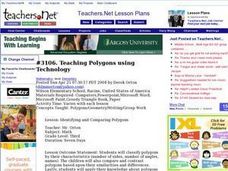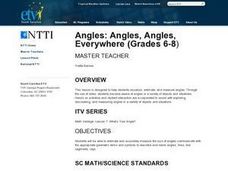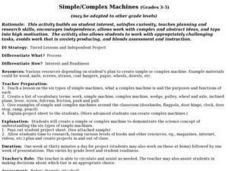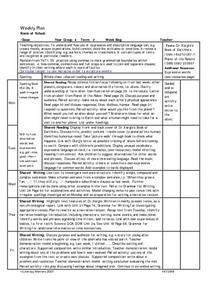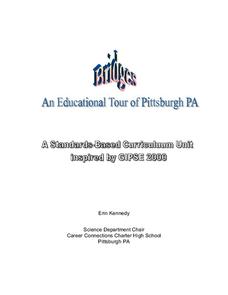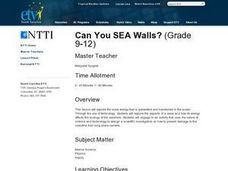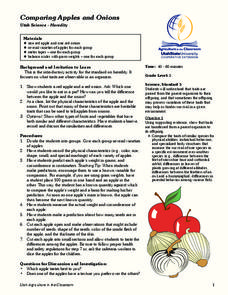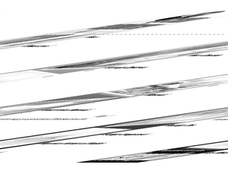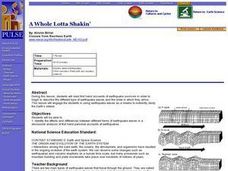Curated OER
Identifying Metamorphic Rocks
In this earth science worksheet, 7th graders classify rock samples according to chart provided and physical properties of the rocks. They answer 2 analysis questions and formulate a conclusion.
Curated OER
All Creatures Microscopically Small
Students investigate physical and behavioral characteristics of different microbes and create research- based 'Microbe Biographies.' students compare microbe sizes and examine how size of a microbe relates to its physical and behavioral...
Curated OER
Why All Maps Lie
Eighth graders discover the fundamental advantages/disadvantages of both maps and globes. They see that maps may distort size, shape, distance and direction. They discuss the advantages and applications of 5 types of map projections and...
Curated OER
Teaching Polygons using Technology
Third graders utilize different types of computer programs, such as Microsoft paint and Microsoft Word to study and create different types of polygons. They use PowerPoint to create a story about a shape and others that it meets during a...
Curated OER
Plagued by Warfare
Students define "biological weapon" and explore why these types of weapons are so dangerous. They also explore the covert shift of American grant research money to an organization that once directed the Soviet Union's germ warfare...
Curated OER
Angles: Angles, Angles, Everywhere
Students practice estiminating and measuring angles. After watching a short video, they identify angles in objects in the classroom and their homes. In groups, they participate in activities in which they are given a scenerio and are...
Curated OER
Hunger and Malnutrition
Students recognize that our bodies cannot function without certain essential foods. In this hunger and malnutrition lesson, students become familiar with the problems associated with malnutrition such as medical problems, problems...
Curated OER
So You Think You're Tough
Fourth graders learn how to classify animals. In this invertebrates lesson, 4th graders discuss how we classify thinks into groups and move into a discussion about classifying animals. Students learn about the differences between...
Curated OER
Simple/Complex Machines
Students make a simple machine. In this physics activity, students learn about six types of simple machines and the purpose of each and brainstorm examples of simple and complex machines in the classroom. Students create a simple or...
Curated OER
Resolving Conflicts
Students practice conflict resolution skills. In this personal health lesson, students share incidents of verbal harassment, exclusion, gossip, and unwanted physical contact. Students discuss how to handle the situations and role play...
Curated OER
Tropism
Students conduct various experiments on tropism. In this biology lesson, students explain how gravity affects the growth of plant roots. They identify the different types of tropisms.
Curated OER
"Dr. Xargle's Book of Earthlets"
Students examine the expressive and descriptive language used in the books "Dr. Xargle's Book of Earthlets" and "Planet of the Robots." In pairs they take notes about each other's physical appearance and conduct interviews, identify the...
Curated OER
Bridges
Students are introduced to the different types, designs and nature of bridges. They observe a historical look at the bridges in and around the Pittsburgh area through a video presentation. Connections are made between science and...
Curated OER
The Phenomenon of Sound: Waves
Students explore sound waves. In this sound waves lesson, students brainstorm different sounds and how sounds move or travel. Students then create a KWL chart and work through six different lab activities to examine how sound waves...
Curated OER
Interdisciplinary Lesson Plan
Third graders study Thanksgiving. In this physical education and spelling lesson, 3rd graders play a race game by being the first group who can spell the word Thanksgiving first.
Curated OER
Drama: Working Together
Students participate in a host of activities designed to encourage creativity, collaboration, and cooperation. They experience walking in different ways, greeting various types of people, and mirroring, where one student duplicates the...
Curated OER
Can You SEA Walls?
High schoolers explore how wave energy that is generated and transferred in the ocean. They explore the aspects of a wave and how its energy affects the ecology of the seashore. Students engage in an activity that uses the nature of...
Curated OER
Does that Sound Right to You?
Ninth graders are introduced to the components of compressional and transverse. They practice answering speed problems involving different mediums that waves travel trhough and then review the wave PowerPoint. They then visit physics...
Curated OER
Comparing Apples and Onions
Fifth graders observe and compare apples. In this apples lesson, 5th graders work in groups to record the physical characteristics of a variety of apples. Students predict each apples weight and then weigh them to see if they were...
Curated OER
Enduring Cultures
Students research the art, dance or a game from the Pacific Northwest Coast Aborigines. In this Canadian Cultures lesson, students view a PowerPoint about the Inuits. Students choose a game , type of artwork or dance to...
Curated OER
Health Grade 5
Fifth graders understand conflict and how to solve them. In this lesson about conflict resolution, 5th graders explore different factors that cause conflict. Students are put into groups and develop a list of examples for a specific kind...
Curated OER
The Tell-Tale Plume
Students examine hydrothermal vents. In this ocean lesson, students identify changes in physical and chemical properties of sea water caused by hydrothermal vents.
Curated OER
Engineering: Simple Machines
Fourth graders participate in activities to examine how simple machines help build things. They identify the six types of simple machines. They discover how simple machines where use historically to build pyramids and how they are still...
Curated OER
A Whole Lotta Shakin'
Students read first hand accounts of earthquake survivors in order to begin the describe the different types of earthquake waves and the order in which they arrive. They engage in using earthquake waves as a means to indirectly study the...



